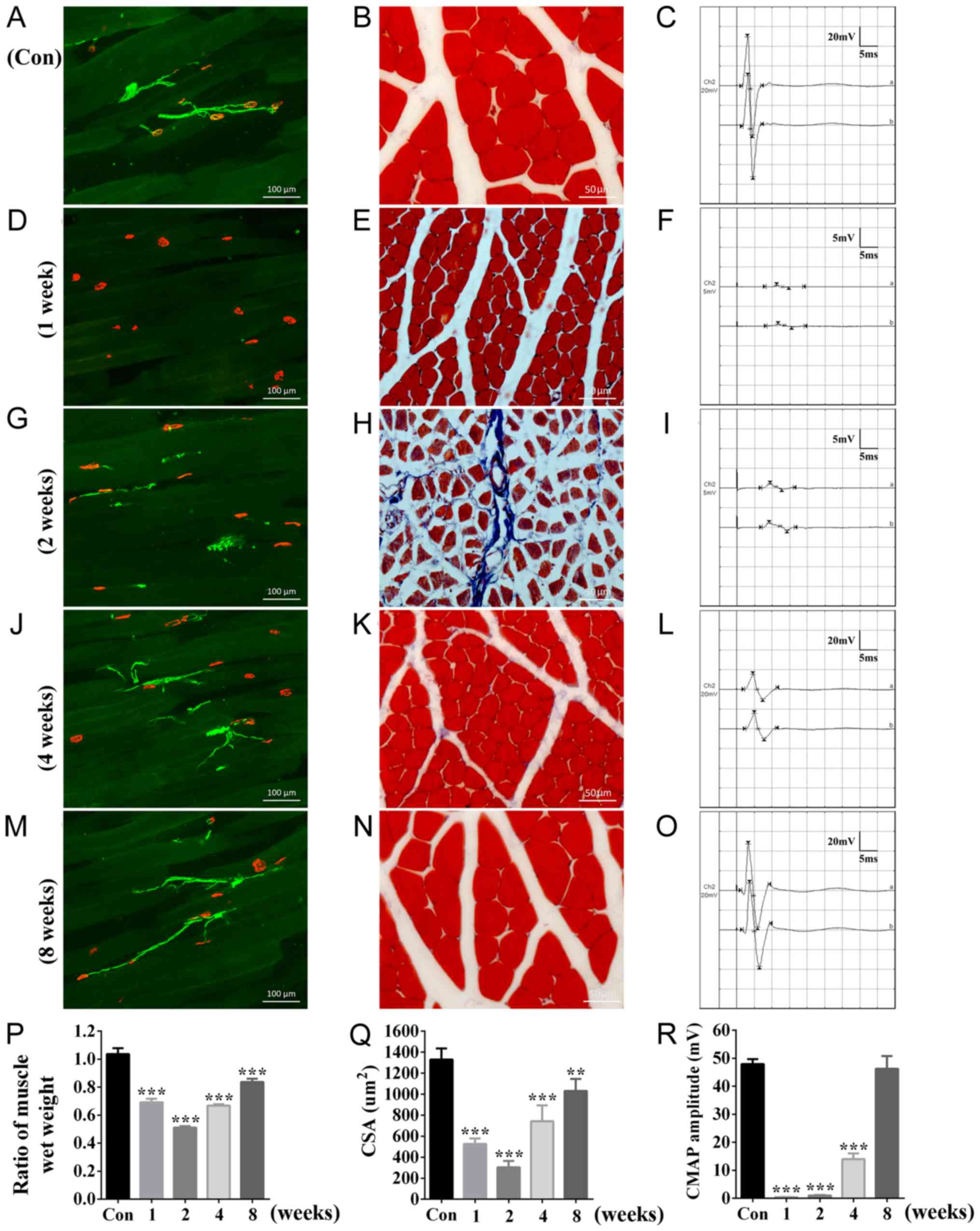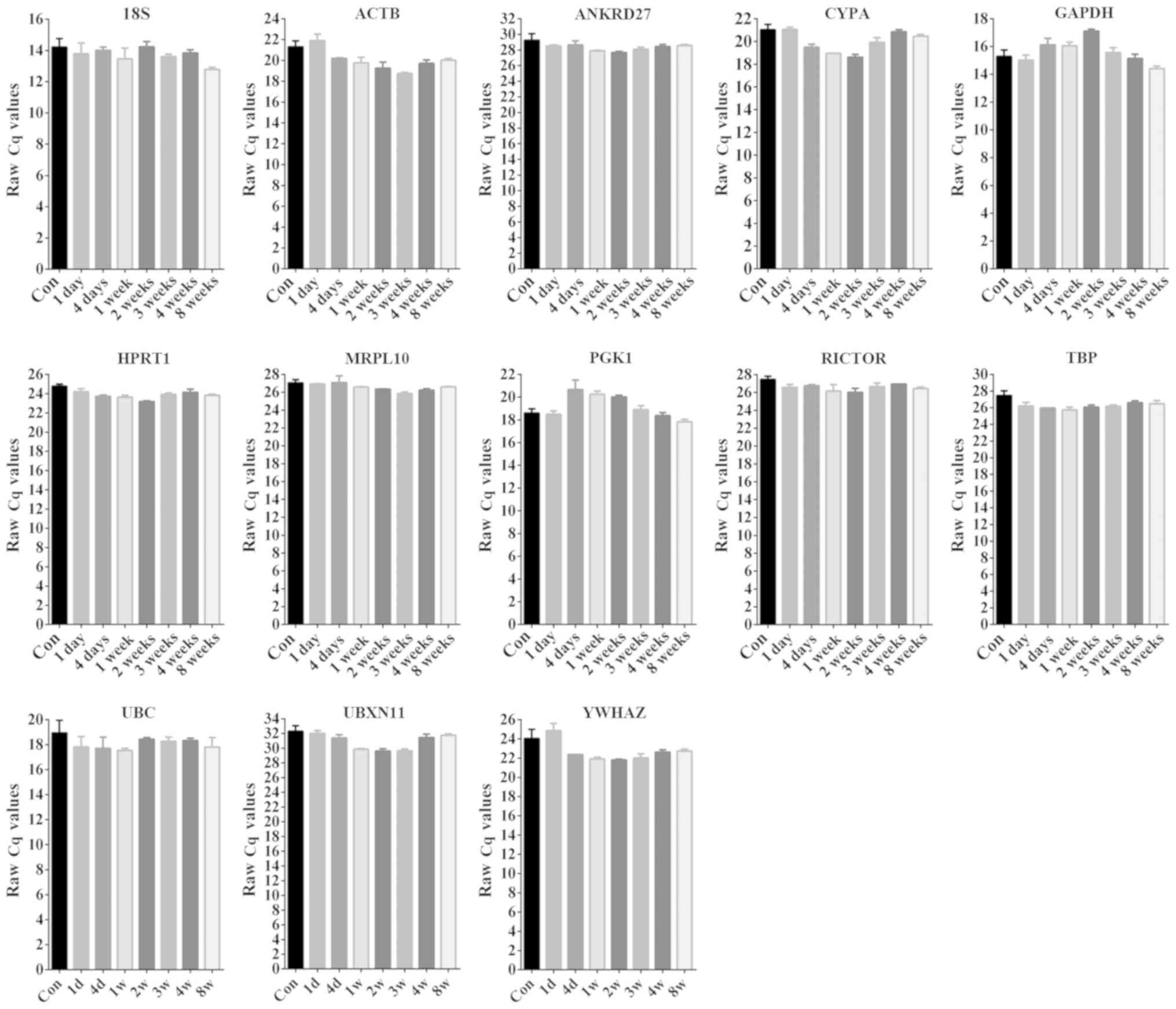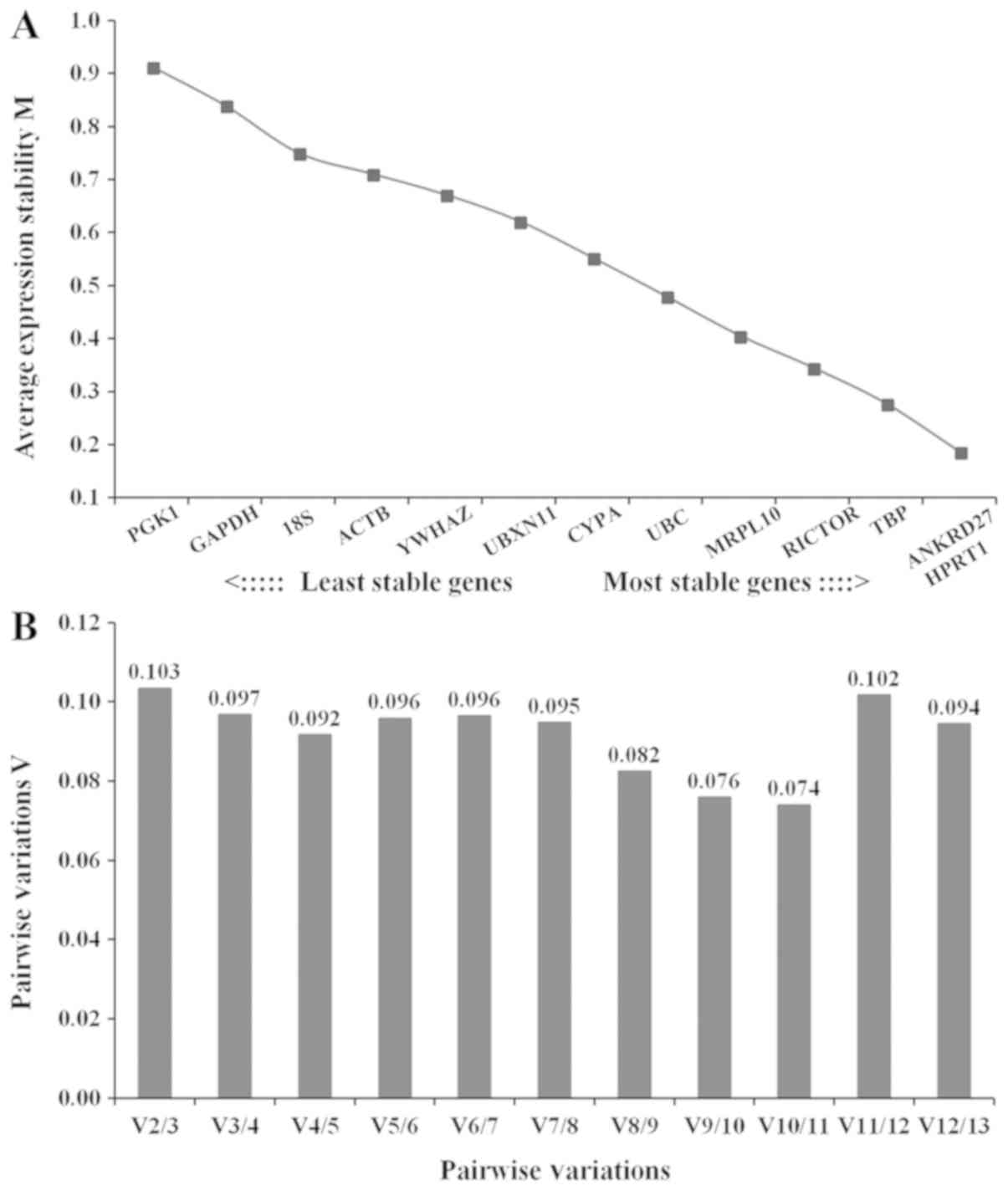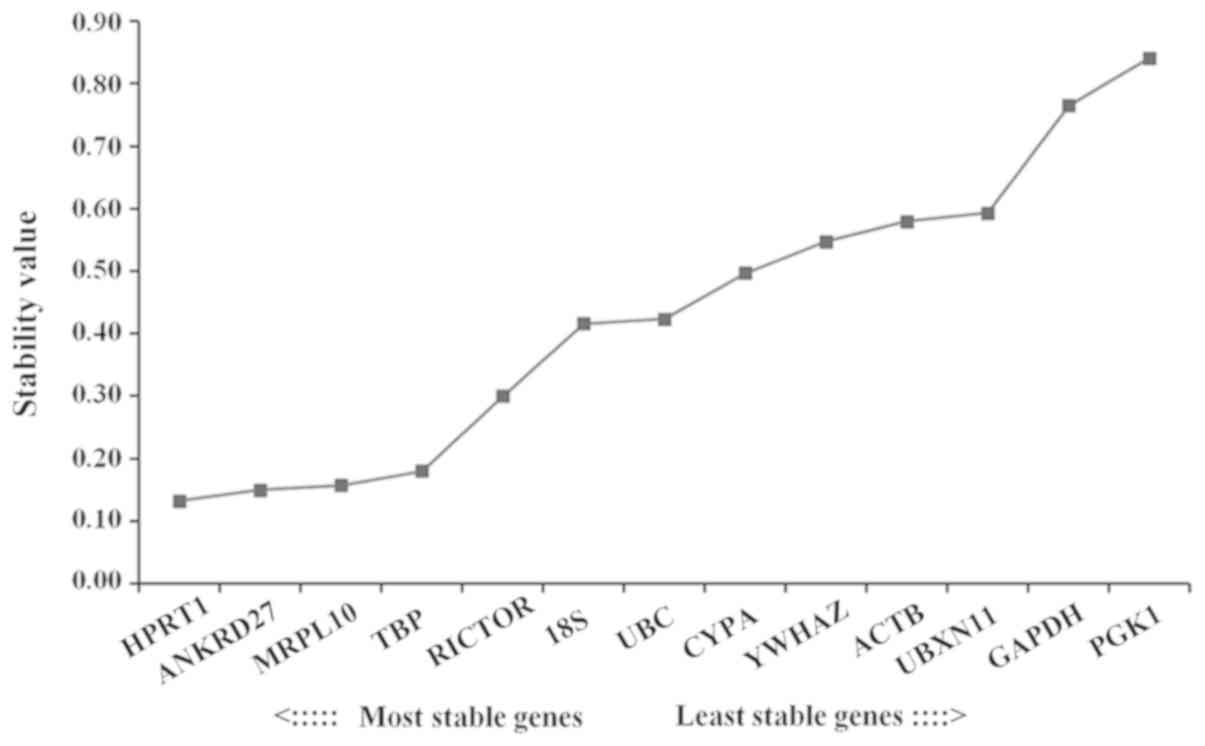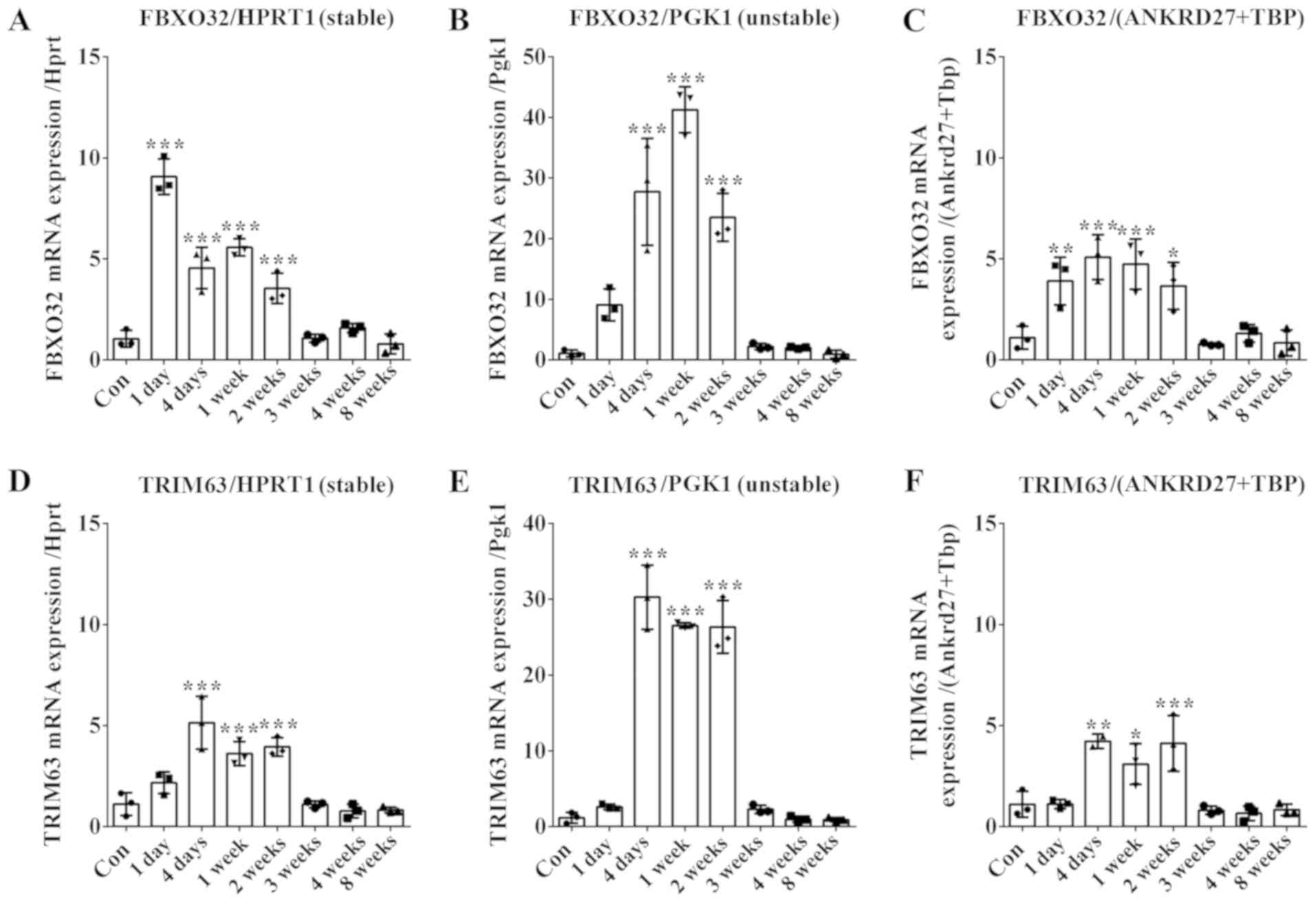|
1
|
Bustin SA: Quantification of mRNA using
real-time reverse transcription PCR (RT-PCR): Trends and problems.
J Mol Endocrinol. 29:23–39. 2002. View Article : Google Scholar : PubMed/NCBI
|
|
2
|
Seol D, Choe H, Zheng H, Jang K,
Ramakrishnan PS, Lim TH and Martin JA: Selection of reference genes
for normalization of quantitative real-time PCR in organ culture of
the rat and rabbit intervertebral disc. BMC Res Notes. 4:1622011.
View Article : Google Scholar : PubMed/NCBI
|
|
3
|
Andersen CL, Jensen JL and Orntoft TF:
Normalization of real-time quantitative reverse transcription-PCR
data: A model-based variance estimation approach to identify genes
suited for normalization, applied to bladder and colon cancer data
sets. Cancer Res. 64:5245–5250. 2004. View Article : Google Scholar : PubMed/NCBI
|
|
4
|
Eisenberg E and Levanon EY: Human
housekeeping genes are compact. Trends Genet. 19:362–365. 2003.
View Article : Google Scholar : PubMed/NCBI
|
|
5
|
Zhu J, He F, Hu S and Yu J: On the nature
of human housekeeping genes. Trends Genet. 24:481–484. 2008.
View Article : Google Scholar : PubMed/NCBI
|
|
6
|
Vandesompele J, De Preter K, Pattyn F,
Poppe B, Van Roy N, De Paepe A and Speleman F: Accurate
normalization of real-time quantitative RT-PCR data by geometric
averaging of multiple internal control genes. Genome Biol.
3:RESEARCH00342002. View Article : Google Scholar : PubMed/NCBI
|
|
7
|
Thellin O, Zorzi W, Lakaye B, De Borman B,
Coumans B, Hennen G, Grisar T, Igout A and Heinen E: Housekeeping
genes as internal standards: Use and limits. J Biotechnol.
75:291–295. 1999. View Article : Google Scholar : PubMed/NCBI
|
|
8
|
Schmittgen TD and Zakrajsek BA: Effect of
experimental treatment on housekeeping gene expression: Validation
by real-time, quantitative RT-PCR. J Biochem Biophys Methods.
46:69–81. 2000. View Article : Google Scholar : PubMed/NCBI
|
|
9
|
Li R, Liu Z, Pan Y, Chen L, Zhang Z and Lu
L: Peripheral nerve injuries treatment: A systematic review. Cell
Biochem Biophys. 68:449–54. 2014. View Article : Google Scholar : PubMed/NCBI
|
|
10
|
Gu X, Ding F and Williams DF: Neural
tissue engineering options for peripheral nerve regeneration.
Biomaterials. 35:6143–6156. 2014. View Article : Google Scholar : PubMed/NCBI
|
|
11
|
Yi S, Zhang H, Gong L, Wu J, Zha G, Zhou
S, Gu X and Yu B: Deep sequencing and bioinformatic analysis of
lesioned sciatic nerves after crush injury. PLoS One.
10:e01434912015. View Article : Google Scholar : PubMed/NCBI
|
|
12
|
Gong L, Wu J, Zhou S, Wang Y, Qin J, Yu B,
Gu X and Yao C: Global analysis of transcriptome in dorsal root
ganglia following peripheral nerve injury in rats. Biochem Biophys
Res Commun. 478:206–212. 2016. View Article : Google Scholar : PubMed/NCBI
|
|
13
|
Wang Y, Shan Q, Meng Y, Pan J and Yi S:
Mrpl10 and Tbp are suitable reference genes for peripheral nerve
crush injury. Int J Mol Sci. 18:E2632017. View Article : Google Scholar : PubMed/NCBI
|
|
14
|
Lien SC, Cederna PS and Kuzon WM Jr:
Optimizing skeletal muscle reinnervation with nerve transfer. Hand
Clin. 24445–454. (vii)2008. View Article : Google Scholar : PubMed/NCBI
|
|
15
|
Irintchev A and Wernig A: Denervation and
reinnervation of muscle: Physiological effects. Eur Arch
Otorhinolaryngol. S28–S30. 1994.PubMed/NCBI
|
|
16
|
Martínez-Martos JM, Carrera-González MP,
Sánchez-Agesta R, García MJ and Ramírez-Expósito MJ: Kidney
aminopeptidase activities are related to renal damage in
experimental breast cancer. J Clin Mol Med. 1:2018. View Article : Google Scholar
|
|
17
|
Livak KJ and Schmittgen TD: Analysis of
relative gene expression data using real-time quantitative PCR and
the 2(-Delta Delta C(T)) method. Methods. 25:402–428. 2001.
View Article : Google Scholar : PubMed/NCBI
|
|
18
|
Bangaru ML, Park F, Hudmon A, McCallum BJ
and Hogan HQ: Quantification of gene expression after painful nerve
injury: Validation of optimal reference genes. J Mol Neurosci.
46:497–504. 2012. View Article : Google Scholar : PubMed/NCBI
|
|
19
|
Bonefeld BE, Elfving B and Wegener G:
Reference genes for normalization: A study of rat brain tissue.
Synapse. 62:302–309. 2008. View Article : Google Scholar : PubMed/NCBI
|
|
20
|
Gambarotta G, Ronchi G, Friard O, Galletta
P, Perroteau I and Geuna S: Identification and validation of
suitable housekeeping genes for normalizing quantitative real-time
PCR assays in injured peripheral nerves. PLoS One. 9:e1056012014.
View Article : Google Scholar : PubMed/NCBI
|
|
21
|
Peinnequin A, Mouret C, Birot O, Alonso A,
Mathieu J, Clarençon D, Agay D, Chancerelle Y and Multon E: Rat
pro-inflammatory cytokine and cytokine related mRNA quantification
by real-time polymerase chain reaction using SYBR green. BMC
Immunol. 5:32004. View Article : Google Scholar : PubMed/NCBI
|
|
22
|
Martínez-Beamonte R, Navarro MA, Larraga
A, Strunk M, Barranquero C, Acín S, Guzman MA, Iñigo P and Osada J:
Selection of reference genes for gene expression studies in rats. J
Biotechnol. 151:325–334. 2011. View Article : Google Scholar : PubMed/NCBI
|
|
23
|
Carvalho RF, Castan EP, Coelho CA, Lopes
FS, Almeida FL, Michelin A, de Souza RW, Araújo JP Jr, Cicogna AC
and Dal Pai-Silva M: Heart failure increases atrogin-1 and MuRF1
gene expression in skeletal muscle with fiber type-specific
atrophy. J Mol Histol. 41:81–87. 2010. View Article : Google Scholar : PubMed/NCBI
|
|
24
|
Rho HW, Lee BC, Choi ES, Choi IJ, Lee YS
and Goh SH: Identification of valid reference genes for gene
expression studies of human stomach cancer by reverse
transcription-qPCR. BMC Cancer. 10:2402010. View Article : Google Scholar : PubMed/NCBI
|
|
25
|
Li P, Waters RE, Redfern SI, Zhang M, Mao
L, Annex BH and Yan Z: Oxidative phenotype protects myofibers from
pathological insults induced by chronic heart failure in mice. Am J
Pathol. 170:599–608. 2007. View Article : Google Scholar : PubMed/NCBI
|
|
26
|
Latres E, Amini AR, Amini AA, Griffiths J,
Martin FJ, Wei Y, Lin HC, Yancopoulos GD and Glass DJ: Insulin-like
growth factor-1 (IGF-1) inversely regulates atrophy-induced genes
via the phosphatidylinositol 3-kinase/Akt/mammalian target of
rapamycin (PI3K/Akt/mTOR) pathway. J Biol Chem. 280:2737–2744.
2005. View Article : Google Scholar : PubMed/NCBI
|
|
27
|
Yoshimura K, Asato H, Cederna PS,
Urbanchek MG and Kuzon WM: The effect of reinnervation on force
production and power output in skeletal muscle. J Surg Res.
81:201–208. 1999. View Article : Google Scholar : PubMed/NCBI
|
|
28
|
Kamath S, Venkatanarasimha N, Walsh MA and
Hughes PM: MRI appearance of muscle denervation. Skeletal Radiol.
37:397–404. 2008. View Article : Google Scholar : PubMed/NCBI
|
|
29
|
Jaweed MM, Herbison GM and Ditunno JF:
Denervation and reinnervation of fast and slow muscles. A
histochemical study in rats. J Histochem Cytochem. 23:808–827.
1975. View Article : Google Scholar : PubMed/NCBI
|
|
30
|
Carlson BM: The Biology of long-term
denervated skeletal muscle. Eur J Transl Myol. 24:32932014.
View Article : Google Scholar : PubMed/NCBI
|
|
31
|
Willand MP, Nguyen MA, Borschel GH and
Gordon T: Electrical stimulation to promote peripheral nerve
regeneration. Neurorehabil Neural Repair. 30:490–496. 2016.
View Article : Google Scholar : PubMed/NCBI
|
|
32
|
Batt J, Bain J, Goncalves J, Michalski B,
Plant P, Fahnestock M and Woodgett J: Differential gene expression
profiling of short and long term denervated muscle. FASEB J.
20:115–117. 2006. View Article : Google Scholar : PubMed/NCBI
|
|
33
|
Nicolino S, Panetto A, Raimondo S,
Gambarotta G, Guzzini M, Fornaro M, Battiston B, Tos P, Geuna S and
Perroteau I: Denervation and reinnervation of adult skeletal muscle
modulate mRNA expression of neuregulin-1 and ErbB receptors.
Microsurgery. 29:464–472. 2009. View Article : Google Scholar : PubMed/NCBI
|
|
34
|
Sun H, Qiu J, Chen Y, Yu M, Ding F and Gu
X: Proteomic and bioinformatic analysis of differentially expressed
proteins in denervated skeletal muscle. Int J Mol Med.
33:1586–1596. 2014. View Article : Google Scholar : PubMed/NCBI
|
|
35
|
Weng J, Zhang P, Yin X and Jiang B: The
Whole transcriptome involved in denervated muscle atrophy following
peripheral nerve injury. Front Mol Neurosci. 11:692018. View Article : Google Scholar : PubMed/NCBI
|
|
36
|
Raffaello A, Laveder P, Romualdi C, Bean
C, Toniolo L, Germinario E, Megighian A, Danieli-Betto D, Reggiani
C and Lanfranchi G: Denervation in murine fast-twitch muscle:
Short-term physiological changes and temporal expression profiling.
Physiol Genomics. 25:60–74. 2006. View Article : Google Scholar : PubMed/NCBI
|
|
37
|
Hsieh CH, Jeng SF, Wu CJ, Lu TH, Yang JC,
Chen YC, Lin CJ and Rau CS: Altered expression of the microRNAS and
their potential target genes in the soleus muscle after peripheral
denervation and reinnervation in rats. J Trauma. 70:472–480. 2011.
View Article : Google Scholar : PubMed/NCBI
|
|
38
|
Jeng SF, Rau CS, Liliang PC, Wu CJ, Lu TH,
Chen YC, Lin CJ and Hsieh CH: Profiling muscle-specific microRNA
expression after peripheral denervation and reinnervation in a rat
model. J Neurotrauma. 26:2345–2353. 2009. View Article : Google Scholar : PubMed/NCBI
|
|
39
|
Li G, Li QS, Li WB, Wei J, Chang WK, Chen
Z, Qiao HY, Jia YW, Tian JH and Liang BS: MIRNA targeted signaling
pathway in the early stage of denervated fast and slow muscle
atrophy. Neural Regen Res. 11:1293–1303. 2016. View Article : Google Scholar : PubMed/NCBI
|
|
40
|
Sellner LN and Turbett GR: The presence of
a pseudogene may affect the use of HPRT as an endogenous mRNA
control in RT-PCR. Mol Cell Probes. 10:481–483. 1996. View Article : Google Scholar : PubMed/NCBI
|
|
41
|
Nelissen K, Smeets K, Mulder M, Hendriks
JJ and Ameloot M: Selection of reference genes for gene expression
studies in rat oligodendrocytes using quantitative real time PCR. J
Neurosci Methods. 187:78–83. 2010. View Article : Google Scholar : PubMed/NCBI
|
|
42
|
Solano ME, Thiele K, Kowal MK and Arck PC:
Identification of suitable reference genes in the mouse placenta.
Placenta. 39:7–15. 2016. View Article : Google Scholar : PubMed/NCBI
|















